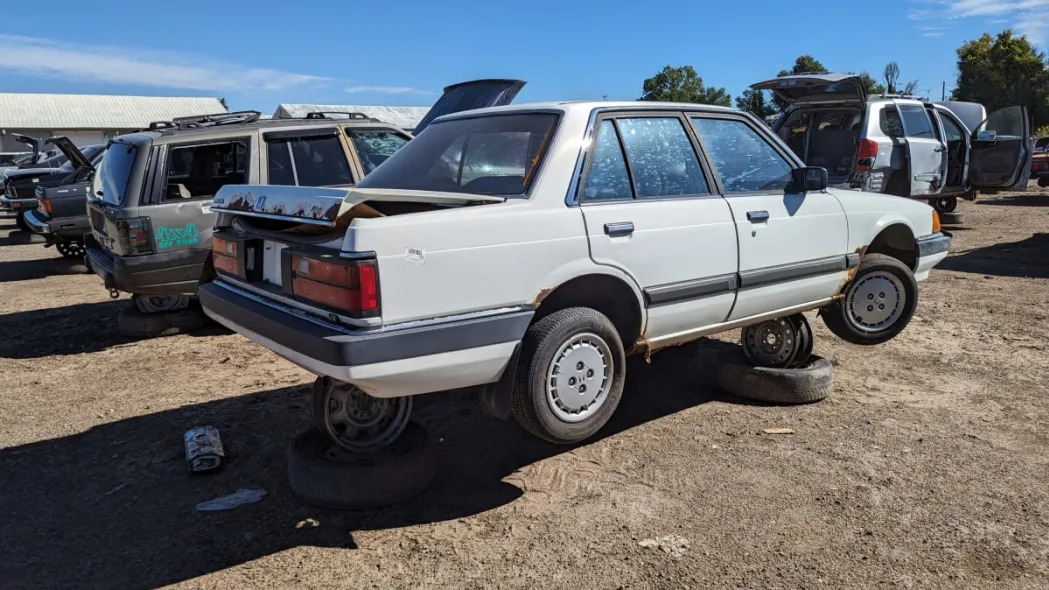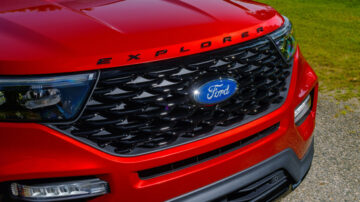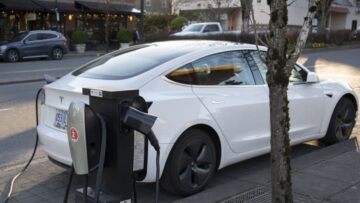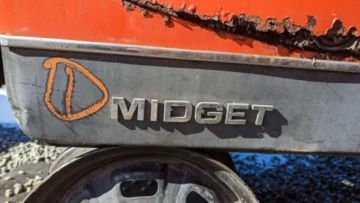Honda is now on the 11th generation of Accord since the first ones hit our shores as 1976 models. Those introductory cars were all hatchbacks, but the first-generation Accord sedan appeared here for the 1978 model year. When the bigger second-generation Accord showed up as a 1982 model, a four-door sedan version remained part of the lineup. Production of the second-gen Accord continued through 1985; these reliable but rust-prone cars have all but disappeared by now, but I’ve found a reasonably solid example in a self-service yard near Denver.

Honda began building Accords at its plant in Ohio starting in 1982 and is now up to 30 million vehicles built in the United States (including motorcycles), but today’s Junkyard Gem was assembled in Saitama Prefecture, Japan.

The only engine available in the U.S.-market 1984 Accord was this 1.8-liter ES2 SOHC 12-valve, rated at 86 horsepower and 98.6 pound-feet. Yes, body-temperature torque!

The 12-valve head design wasn’t about making screaming horsepower; four of those valves were tiny ones that fed a rich mixture into preliminary combustion chambers as part of Honda’s revolutionary CVCC system.

The Compound Vortex Controlled Combustion system was a stratified-charge design that involved what amounted to two carburetors in a single unit, with one feeding a lean mixture to the main combustion chambers and the other sending a richer, easier-to-ignite fuel-air mix to little combustion chambers separated from the main ones by a mesh grate. The spark plugs ignited the rich mix, which then spread the fire to the lean mix next door. The result was extremely clean combustion (by the standards of the 1970s) that didn’t require a catalytic converter or other complex and/or costly hardware to meet the increasingly stringent emissions standards of the United States.

The first CVCC-equipped Civics showed up in the United States as 1975 models, passing the requirements of the Clean Air Act with ease while other manufacturers struggled with various kludges that killed performance and fuel economy. However, as federal and then California emissions requirement got stricter, the CVCC system itself was the one to be burdened with kludgy workarounds. By the middle 1980s, the vacuum hose diagrams for U.S.-market CVCC engines resembled a map of the universe, surpassed in complexity only 15 years later by General Stanley McChrystal’s notorious Afghanistan Stability/COIN Dynamics PowerPoint slide.

The problem was more related to carburetion rather than the CVCC system, because it’s a nightmare to get a technology invented in 1887 to keep levels of internal-combustion hydrocarbons, carbon monoxide and nitrogen oxides at very low levels under every conceivable combination of environmental conditions and driving situation, especially when you have separate rich/lean circuits in your carbs. What do you do when a car hits a sudden downhill grade at 6,000 feet elevation when it’s 100°F outside and the carburetor butterflies suddenly slam shut? With computerized electronic fuel injection running a closed-loop system, no problem! With a carburetor, you need a bunch of sensors, solenoids, etc., just for that one situation … and there are dozens of additional special situations like that one.

Honda bought time by adding computer control to some CVCC components; the mid-1980s system worked very well when every one of its bewildering tangle of components functioned correctly, but could be maddening to diagnose and repair when something went wrong. Honda began selling cars with its PGM-FI fuel-injection system here in the 1985 model year; the final U.S.-market CVCC cars were 1987 models (non-CVCC carbureted Accords and Preludes were sold here through 1989). Automotive history is what we look for in the junkyard!

For 1984, there were two grades of the Accord in the United States: base and LX. This one is a top-of-the-range LX with automatic, so its MSRP would have been $10,299 (about $31,365 in 2024 dollars). Honda still uses the LX designation, but it goes on the cheapest Accord; the swankier 2024 Accord EX starts at $29,910 and is far bigger, faster, safer and more comfortable than its predecessor of four decades back. You see, the old days weren’t always better; the 2024 Accord even gets much better fuel economy than the 1984 Accord, despite the ’24 weighing a half-ton more than the ’84 and despite the ’24 being a lot cheaper in adjusted dollars.

Amazingly, the LX Accord came with what would have been considered an excellent audio system by mid-1980s standards. AM, FM and cassette with track sensing, Dolby and metal capability, plus a three-band equalizer and digital tuning.

The second-generation Accord was a very good value for its era and it maintained a strong resale value for decades (it was only when smog-testing regimens in some states got much stricter in the early 2000s that it became difficult to pass an emissions test in a CVCC Accord). I’ve found one discarded example with well over 400,000 miles on the odometer, in fact.

This one made it to 214,719 miles, which is respectable but nowhere near outstanding for a 1980s Accord. For a junkyard 1980s Accord odometer to really impress me, it needs to show better than 600,000 miles, or at least 500,000. It’s very unusual for a junkyard Honda with the little mechanical maintenance indicators on the speedometer to not be showing red across the board; few bother to reset them even when service takes place.

I’ll bet it was a runner when it got here, but the rust doomed it. Road salt is used sparingly here, and the single-digit humidity dries out damp areas before they can rot from weatherstripping leakage, but Japanese cars of this era were tasty snacks for the Rust Monster even in not-so-corrosion-prone regions.
It appears that most second-gen Accord commercials were for the hatchback, but here’s one for the fuel-injected 1985 Accord SE-i sedan.
In Japan, this generation of Accord sedan got classy SALOON badges on the decklid.
- SEO Powered Content & PR Distribution. Get Amplified Today.
- PlatoData.Network Vertical Generative Ai. Empower Yourself. Access Here.
- PlatoAiStream. Web3 Intelligence. Knowledge Amplified. Access Here.
- PlatoESG. Carbon, CleanTech, Energy, Environment, Solar, Waste Management. Access Here.
- PlatoHealth. Biotech and Clinical Trials Intelligence. Access Here.
- Source: https://www.autoblog.com/2024/03/31/junkyard-gem-1984-honda-accord-sedan/
- :is
- $UP
- 000
- 1
- 10
- 11
- 11th
- 12
- 13
- 14
- 15 years
- 15%
- 16
- 17
- 19
- 1985
- 2%
- 20
- 2000s
- 2024
- 21
- 214
- 22
- 23
- 24
- 25
- 26
- 27
- 28
- 29
- 30
- 31
- 32
- 33
- 34
- 35%
- 36
- 4
- 400
- 5
- 500
- 6
- 7
- 8
- 84
- 9
- 98
- a
- About
- accord
- across
- adding
- Additional
- Adjusted
- AIR
- All
- always
- am
- an
- and
- appeared
- appears
- ARE
- areas
- AS
- assembled
- At
- audio
- Automatic
- automotive
- available
- back
- badges
- base
- BE
- became
- because
- been
- before
- began
- being
- Bet
- Better
- bigger
- bought
- Building
- built
- Bunch
- but
- by
- california
- came
- CAN
- capability
- car
- carbon
- Carbon monoxide
- cars
- cheaper
- cheapest
- circuits
- clean
- combination
- comfortable
- commercials
- complex
- complexity
- components
- computer
- conditions
- considered
- continued
- control
- correctly
- costly
- could
- decades
- Denver
- Design
- designation
- Despite
- diagnose
- diagrams
- didn
- difficult
- digital
- discarded
- do
- dollars
- Doomed
- Door
- dozens
- driving
- Early
- ease
- economy
- Electronic
- Elm
- Emissions
- Engine
- Engines
- environmental
- EPA
- equalizer
- Era
- especially
- etc
- Even
- Every
- example
- excellent
- extremely
- fact
- far
- faster
- Fed
- Federal
- feeding
- Feet
- few
- final
- Fire
- First
- For
- found
- four
- from
- Fuel
- Gem
- General
- generation
- get
- gets
- Goes
- good
- got
- grade
- Hardware
- Have
- head
- here
- history
- Hit
- Hits
- However
- HTML
- HTTPS
- i
- in
- increasingly
- Indicators
- into
- introductory
- Invented
- involved
- IT
- ITS
- itself
- Japan
- Japanese
- jpg
- just
- Keep
- leakage
- least
- levels
- like
- lineup
- little
- ll
- Look
- Lot
- Low
- low levels
- made
- Main
- maintained
- maintenance
- Making
- Manufacturers
- map
- mechanical
- Meet
- mesh
- metal
- Middle
- million
- mix
- mixture
- model
- models
- more
- most
- much
- Near
- Need
- needs
- next
- no
- notorious
- now
- nowhere
- of
- Ohio
- Old
- on
- ONE
- ones
- only
- or
- Other
- our
- out
- outside
- outstanding
- over
- part
- pass
- Passing
- performance
- Place
- plant
- plato
- Plato Data Intelligence
- PlatoData
- plus
- PoS
- predecessor
- preliminary
- Problem
- Production
- rated
- rather
- Red
- regions
- related
- reliable
- remained
- require
- requirement
- Requirements
- respectable
- result
- revolutionary
- Rich
- richer
- road
- runner
- running
- Rust
- s
- safer
- salt
- screaming
- SEC
- see
- Self-service
- sending
- sensors
- separate
- service
- show
- showed
- shut
- since
- single
- situation
- situations
- snacks
- So
- sold
- solid
- some
- something
- special
- spread
- standards
- stanley
- Starting
- starts
- States
- Still
- stricter
- stringent
- strong
- sudden
- surpassed
- system
- T
- takes
- Technology
- test
- than
- that
- The
- Them
- then
- There.
- These
- they
- this
- those
- Through
- time
- to
- today
- track
- tuning
- two
- under
- unit
- United
- United States
- unusual
- used
- uses
- Vacuum
- value
- valves
- various
- Ve
- Vehicles
- version
- very
- was
- wasn
- we
- webp
- weighing
- WELL
- went
- were
- What
- when
- which
- while
- with
- worked
- would
- Wrong
- Yahoo
- year
- years
- yes
- you
- Your
- youtube
- zephyrnet










